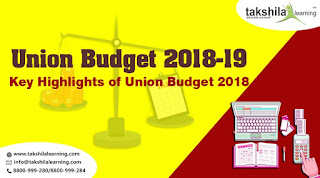Budget 2018 highlights: Arun Jaitley’s speech focuses on health, agriculture, infra
100 Key Highlights of Union Budget 2018 – 19
- No changes in tax structure for salaried class and in slab rates
- 44 lakhs crores paid by salaried taxpayers. A standard deduction of Rs 40,000 for salaried taxpayers, in lieu of transport and medical reimbursements for salaried classes.
- The government will have a scheme to provide a unique ID to every enterprise in India.
- 100% tax rebate for farmer producer companies having a turnover of ₹ 100 crores:
- Proposes 25% corporate tax rate for companies with turnover up to ₹. 250 crores
- Deduction on Health Insurance for senior citizens under 80D increased to Rs 50,000 from Rs 30,000.
- Exemption on interest income from 10000 to 15000, no TDS from this for senior citizens.
- Deduction u/s 80DDB to be increased to ₹ 1,00,000 for all senior citizen.
- Exemption of interest income annually earned from deposit in banks and post offices to increase from Rs 10,000 to Rs 50,000
- short-term capital gains continue to be taxable at 15%
- Introduces Long-Term Capital Gains Tax. LTCG are now taxed at 10% If capital exceeding 1 lakh. There is a strong case to bring long-term capital gains under the tax net, says the finance minister. Gains over Rs 1 lakh will be taxed at 10%.
- Long-term capital gains exceeding 10 lakh to be taxed at 10% without benefit of indexation
- Propose to introduce tax on distributed income by equity-oriented mutual funds at 10%:
- Customs duty on mobile phones increased from 15% to 20%.
- 3% Education cesses to be replaced by a 4% Health Cess
- Govt does not recognize cryptocurrencies as legal tender. Government to consider the use of blockchain to move towards a digital Rs 3073 crore allocated for Digital India
- Projecting the Fiscal Deficit at 3.3% of the GDP. Revised fiscal deficit estimate for 2017-18 is 3.5% of GDP, fiscal deficit of 3.3% expected for 2018-19
- Increase in a number of taxpayers from 6.47 lakh crore in 2014-15 to 8.27 lakh crore. Growth in personal collections and increase in no. of tax returns due to strong anti-tax evasion measures
- Tax compliance behavior of presumptive income taxpayers not encouraging. 41% more returns were filed under presumptive income scheme
- 90,000 Cr Extra Collected As Personal Income Tax in Last 1 Year. Will Continue With Tax Policies That Reward Honest Tax Payers
Learn complete Budget 2018 highlights here.....
For more inquiries about courses offered, regular articles on various topics, video lectures, online test series for Bank Clerk, register with Takshila Learning.

Comments
Post a Comment
Thank you we will contact ASAP.